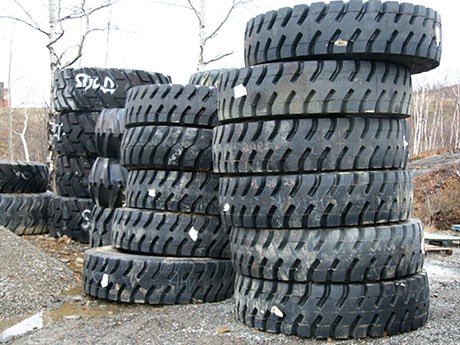Recycling fees for OTR tires top out at $1,311.24
Consumers of off-the-road (OTR) tires in Ontario’s mining industry are being asked to share their views on the costs and operation of the province’s tire recycling program following an uproar over wildly escalating fees tacked on to the price of every OTR tire.
From September 1, 2009 to March 31, 2013, so-called tire stewardship fees for OTR tires ranged from $12.51 to $250.20 depending on tire size. As of April 1, mining companies are paying up to $1,311.24 for the monster tires used in surface operations.
The abrupt increase in fees was the result of a $25 million deficit in the OTR tire recycling program that led the Minister of Environment to insist that fees be based on “a cost recovery approach.” Ontario’s used tire program is operated by the Ontario Tire Stewardship (OTS), a private, non-profit organization established under the Waste Diversion Act of 2009 and run by tire manufacturers and importers.
“Up until last year, the fees for OTR tires were based on estimates and that’s where things got a little bit out of whack,” said Michael Scott, chief executive officer of Waste Diversion Ontario, the agency responsible for overseeing the OTS. “When the program began, there was very little data on how many OTR tires were going to be available for diversion and how many tires were going to be sold into the Ontario market. At the beginning of the program, the estimate of tires being sold was significantly higher than what actually occurred and the estimate of the number of tires that would be available for recycling was significantly lower, so right off the bat, deficits started to occur.”
An uproar from consumers of OTR tires prompted Minister of Environment Jim Bradley in November to freeze recycling fees for the fiscal year beginning May 1 and to direct Waste Diversion Ontario to conduct a review of the OTR recycling program.
Bradley directed Waste Diversion Ontario to strike a multi-stakeholder advisory committee, conduct broader public consultation and report back by September 12. The mining industry is represented on the committee by Frank Francouer, a Goldcorp employee.
Part of the problem, Bradley acknowledged, was the “lack of consumer involvement in decisions and representation on the OTS Board of Directors.”
Fees
Fees levied by the OTS pay collectors, haulers and processors of used tires. “Tire recycling infrastructure was in its infancy five years ago when the used tire program began,” said Scott. “Processors came into the market in response to incentives and stimulus to create the required infrastructure for getting all those tires out of the waste stream. They’re still paying those incentives.”
There are approximately 12 processors in Ontario turning used tires into mud flaps for transports, truck bed mats, roofing tiles and playground surfaces.
The OTS also uses recycling fees for research and development, marketing and demonstration projects to promote the use of rubber products derived from recycled tires.
“It’s a very expensive program,” acknowledged Scott, but it has succeeded in diverting more than 60 million tires from landfill disposal and preventing repeat occurrences of the Hagersville fire of 1990 that consumed 12 to 14 million tires, burned for 17 days and forced the evacuation of 4,000 people from their homes.
Jason Desjardins, manager of Kal Tire’s location in Sudbury acknowledges that mining companies are concerned about the increased fees, but points out that they need tires to operate.
The very biggest tires used at Detour Gold’s open pit mine north of Timmins are 16 feet, eight inches high and five feet wide, said Desjardins. They sell for between $60,000 and $80,000 each, plus the tire stewardship fee of $1,311.24.
Miners also have the option of retreading a tire, depending on its condition, he noted. Retreading costs a third of the price of a new tire, and incurs no recycling fee.
A complete overhaul of tire recycling in Ontario is proceeding along another path.
In his letter to the chair of Waste Diversion Ontario ordering the review, Bradley admitted that “some of the challenges and concerns faced by OTR stewards and their consumers may not be satisfactorily resolved (under current legislation).
Waste Reduction Act
“That is why I introduced the Waste Reduction Act which, if passed, would make (manufacturers and importers) responsible for the end-of-life management of their products.”
The Waste Reduction Act, currently in second reading in the legislature, would give manufacturers and importers “a choice in terms of how they would fulfill (their tire recycling) obligations,” said Scott.
“They could join together as a collective. They could do it on their own, or they could contract out to another organization. Under the new legislation, the current organization (the OTS) would either be phased out or would transition into something new.
“What the government is really trying to get at is the feeling that in some cases, the current organizations that we oversee have undue market powers to set prices and pay incentives, and this has caused all kinds of complaints … by stakeholders.”
Mining companies interested in sharing their views on tire recycling can complete a survey at www.surveymonkey.com/s/8QYQBZ5 and follow the progress of the review on the Waste Diversion Ontario website.



